
UTM: Mr Galland, what is your position within Axis Communications and what areas do you work for?
Maximilian Galland: I am Manager Sales DACH at Axis Communications, technology leader in network video, and I am therefore responsible for sales in Germany, Austria and Switzerland.
UTM: How is Axis Communications positioned in the German-speaking and global market? How many employees work in your company and at which locations or in which countries do you produce?
Maximilian Galland: Axis Communications was founded in 1984 in Lund, Sweden. From the beginning, the company’s goal was to create a smarter and safer world by developing solutions to improve security and business performance. At that time, the idea of connecting and adding intelligence to devices using network technology was still new. In fact, Axis launched the world’s first IP video camera in 1996 – and also laid the foundation for the industry’s shift from analogue to IP-based video security systems. Today, Axis has over 150 network camera models for different use cases and industries, such as traffic or smart city, as well as video analytics and access control solutions, intercoms, audio systems and wearables. Axis employs about 4,000 people and has customers and partners in over 50 countries worldwide.
UTM: What are the current product highlights of Axis Communications and what are the most important markets for you?
Maximilian Galland: At InnoTrans 2022 in Berlin, we presented Axis’ first onboard camera with 360-degree panoramic view. The AXIS M3057-PLR MKII fisheye camera has a resolution of 6 megapixels and can therefore efficiently capture and cover large interior areas in buses, trams and trains. It can be used not only to improve passenger safety, but also to effectively measure vehicle occupancy in individual train compartments.
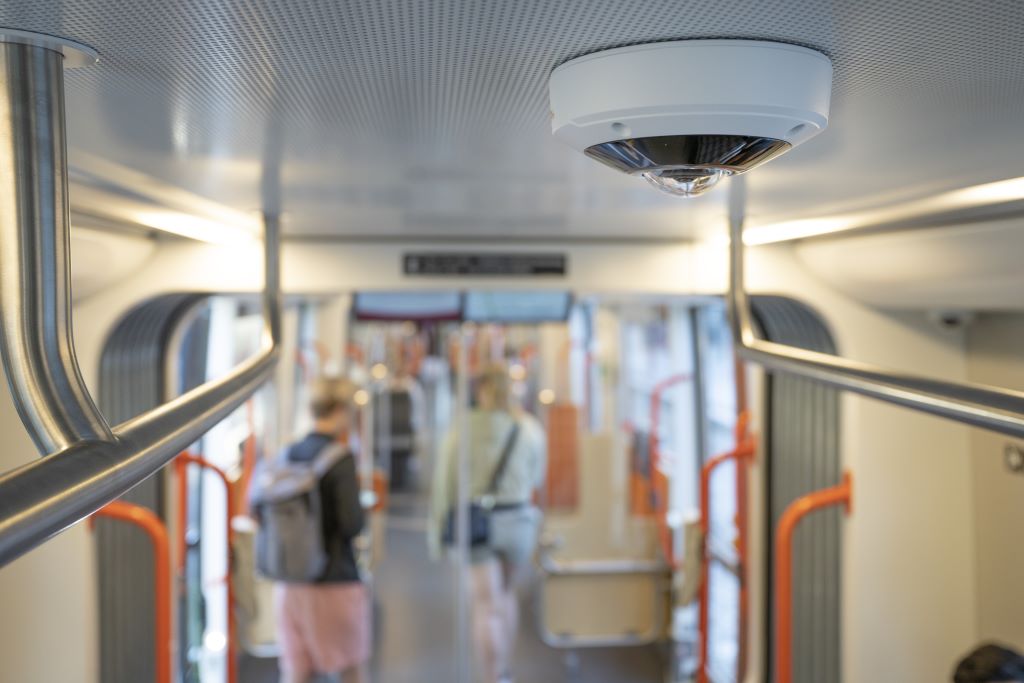
We also recently launched our first radar video fusion camera. The AXIS Q1656-DLE is the first camera to combine radar and video functionality in one device. In addition, the camera offers AXIS Object Analytics, a Deep Learning-based analysis function that helps to locate and classify objects, such as running people.
In terms of markets, Axis Communications focuses in particular on the three world regions: AMERICAS (North, Central and South America), EMEA (Europe, Middle East and Africa) and APAC (Asia Pacific). The region of North, Central and South America makes up the largest market. In terms of industries, Retail, Transportation, Smart Cities and Critical Infrastructure are the most important industry segments for us globally.
UTM: In October, Axis Communications launched the “Noise Camera” project. What is special about it and what are the project goals?
Maximilian Galland: The “Noise Camera” was developed as part of a pilot project in Eindhoven, the Netherlands, in cooperation with Sorama, the market leader in noise cameras. In Eindhoven, both noise pollution and air pollution are sometimes very high, especially along the six-lane Kennedylaan, one of the busiest streets in the city. The municipality therefore set itself the goal of reducing noise pollution. In fact, noise is an important aspect of smart city projects, because it promotes numerous civilisation diseases such as sleep disorders or high blood pressure. Less noise therefore automatically contributes to a higher quality of life in cities. The project was first presented at Intertraffic Amsterdam in March 2021.
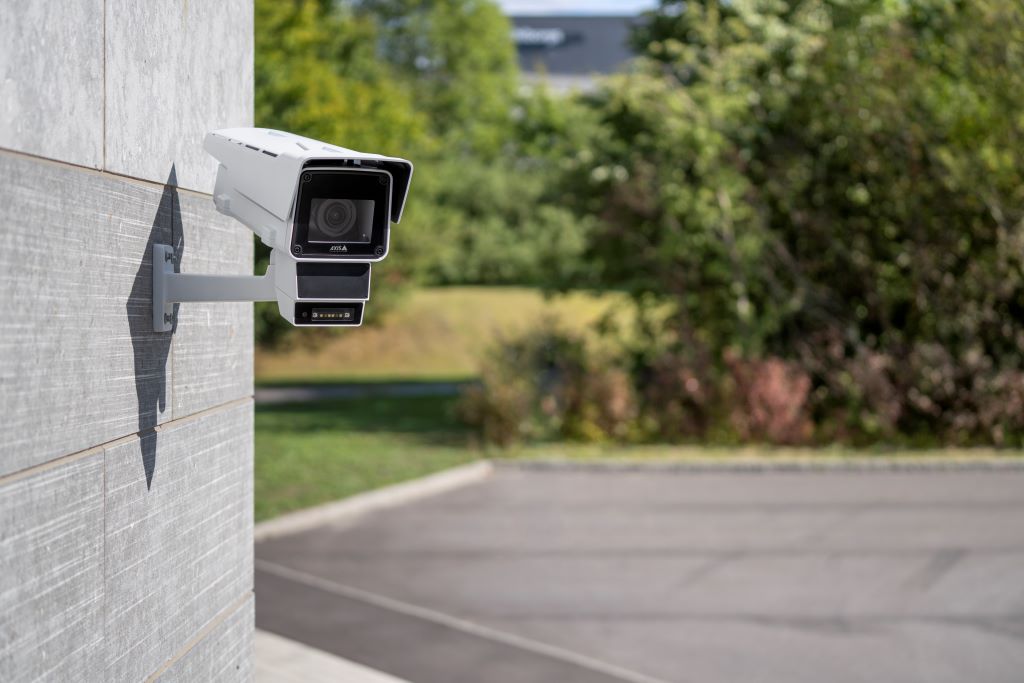
UTM: How does the noise camera work?
Maximilian Galland: As part of the Noise Camera pilot project, we installed a total of eight IP camera systems on the Kennedylaan in Eindhoven, which continuously monitor the volume of traffic and the resulting noise level. Each system consists of a Sorama sensor with a total of 64 microphones that register where a noise is coming from and how loud it is, and an IP-based bullet camera from Axis Communications – the AXIS P1455-LE or AXIS Q1700-LE models. Both cameras have the AXIS License Plate Verifier analysis feature, which allows them to effectively detect and read vehicle number plates.
Ultimately, the whole setup works like this: The Sorama sensor continuously measures the noise level of the environment. If this deviates from predefined thresholds, a pulse is sent to the Axis camera, which then uses AXIS License Plate Verifier to mark the number plates of the vehicles visible in the frame at that moment.
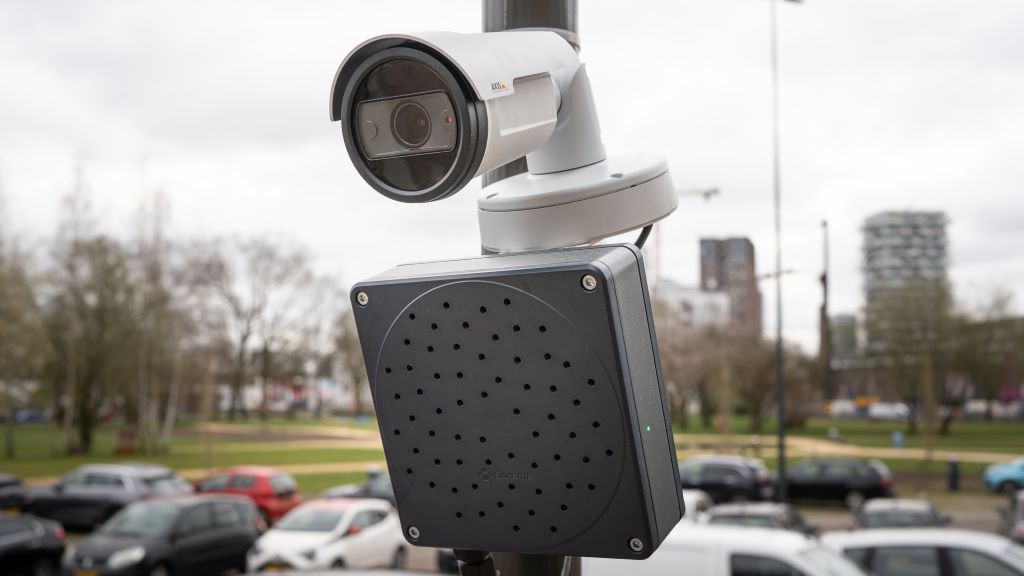
Both the triggering sound and the video fragment with the marked number plate and optionally other vehicle information, such as the type or colour of the vehicle, are then transmitted as a whole to a video management system. This makes real-time verification and follow-up of the incident possible. Alternatively, the information can be stored in an archive for further follow-up or later processing.
UTM: What are the advantages of the noise camera and why will it become even more important in the future?
Maximilian Galland: Until now, it was only possible to measure the overall sound levels of specific sections of road in cities. By combining noise sensors, network cameras and intelligent analysis functions for number plate recognition, individual vehicles can now also be classified. Only this makes it possible to take concrete measures to reduce noise pollution. A city can, for example, track speeding at certain times or adapt the streetscape accordingly. The latter leads to a city moving from a reactive approach to proactive prevention of noise pollution. As it will become increasingly important in the future to design cities as liveable and also smart places, this is a decisive advantage.

UTM: What reactions have you received from cities and potential customers regarding the noise camera?
Maximilian Galland: We presented the noise camera for the first time in March 2021 at Intertraffic Amsterdam and have since also presented it at other trade fairs, for example Smart City Expo 2022 in Barcelona. The camera has always met with lively interest from customers and partners. Basically, we have the feeling that cities are very open to paying more attention to the issue of noise pollution. They are willing to take steps towards a city centre that is quieter and safer for all residents.
UTM: At InnoTrans you also showed your innovations in the DB Regio AG “Ideenzug” (idea train). What are the technical solutions and how do they work?
Maximilian Galland: The importance of IP technologies for analysing vehicle occupancy on trains as well as the collection of demographic data is continuously increasing. The aim is to increase the safety and comfort of passengers – especially children, cyclists and people with disabilities – when boarding and alighting, as well as to optimise passenger management in order to make public transport more attractive for travellers overall. This is exactly what Axis’ network technologies on the Idea Train aim to achieve, hand in hand with solutions from other Deutsche Bahn partners.
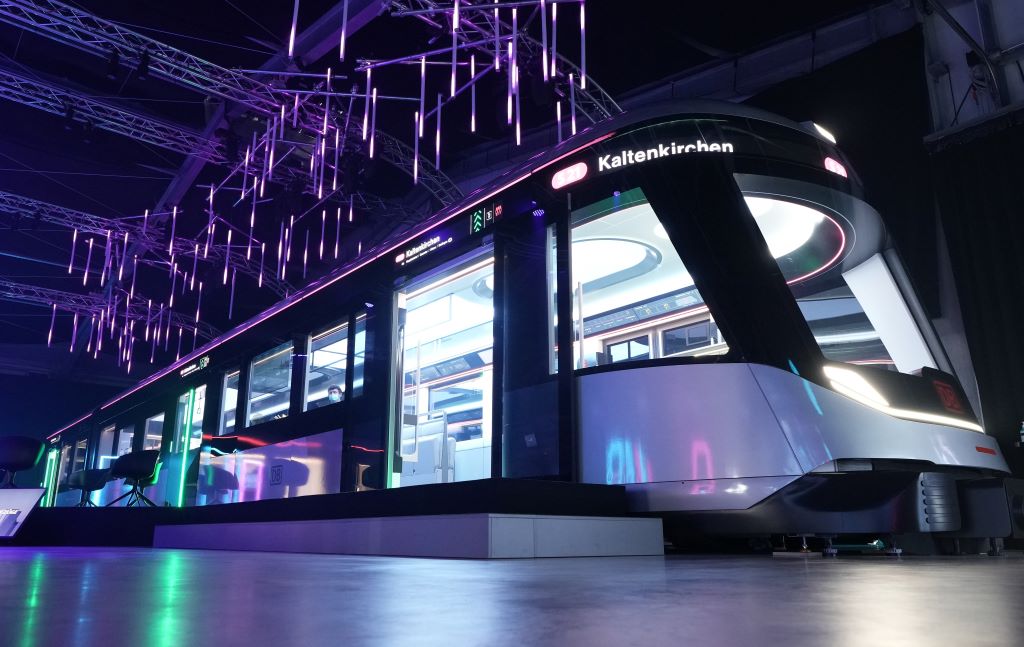
Specifically, as a partner of the “Idea Train”, we presented use cases for public transport from the areas of video- and audio-based network and security technologies as well as cloud-based video security systems at InnoTrans. One example: Our cameras in the trains with integrated analysis function measure the vehicle occupancy rate including seat occupancy in order to provide passengers with information about the occupancy rate of the respective carriage before boarding (e.g. whether spaces for prams, bicycles or wheelchairs are already occupied). The data collected via the analysis software can be evaluated in real time and forwarded to a passenger information system. Finally, the vehicle occupancy – whether low, medium or high – is shown on the digital overdoor displays above the entrance doors. This way, passengers can see and assess how full the respective train section is in real time, even before boarding the train.
UTM: Which trends do you see in the public transport industry? Does AI play a role in your product portfolio?
Maximilian Galland: During the pandemic, in which passenger numbers fell sharply, but especially after last summer, in which there were overloads in public transport due to the 9-Euro ticket in Germany, one thing remains essential in my view: passengers must regain more trust in public transport, i.e. trust in safety and ultimately also in the reliability of the information about the respective environment in which they are moving. For the responsible railway companies, this means that they should be able to make predictions about passenger and vehicle movements that are as reliable as possible. To do this, they need to collect real-time data.
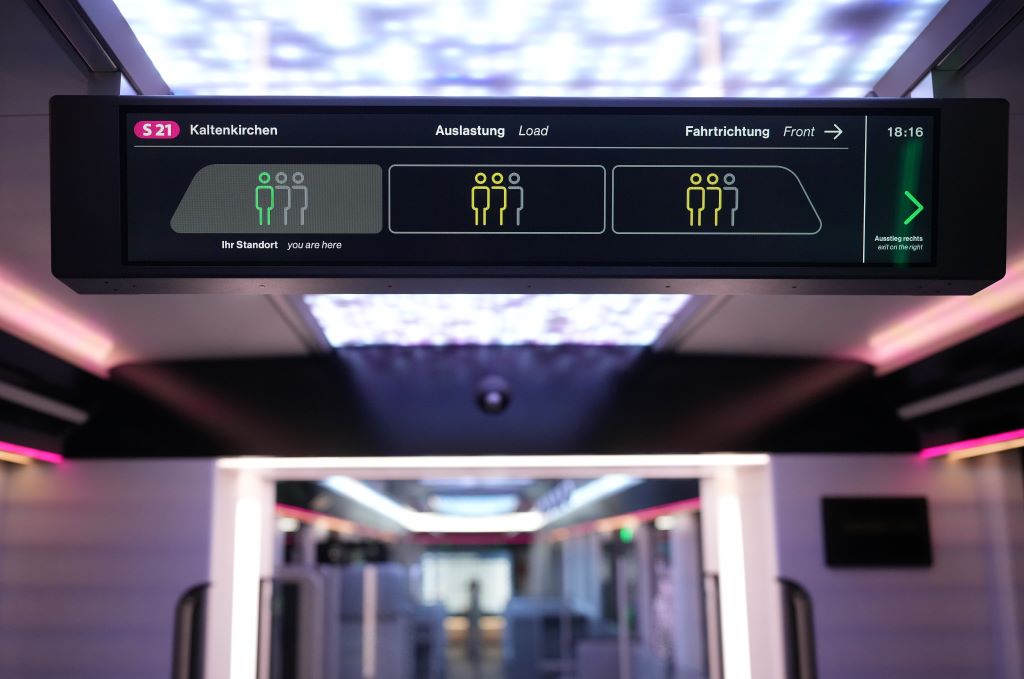
This is where network technology plays a crucial role – usually in the form of IP video solutions in combination with AI-based analysis functions directly on the cameras, which offer greater reliability in measuring vehicle utilisation thanks to machine and deep learning algorithms.
UTM: How do you deal with cybersecurity and how do you protect your products against cyberattacks?
Maximilian Galland: Cybersecurity is a high priority at Axis. Our network products always offer a variety of built-in cybersecurity features to counteract cyberattacks and prevent unauthorised access to systems. Here are a few examples: Axis uses signed firmware with RSA encryption as standard in its products. The Secure Boot software ensures that a device can only be put into operation with authorised Axis firmware. For the past five years, Axis has also offered a long-term support programme for the Axis firmware (AXIS OS). Long Term Support (LTS) delivers important bug fixes and vulnerability patches without affecting camera functionality. By maintaining the camera’s functionality and only releasing firmware updates to fix bugs and vulnerabilities, AXIS OS is able to provide long-term support.
But what if an attacker has not manipulated the firmware, but has replaced an entire device, thus establishing a connection to a secured network? The Axis Edge Vault security component ensures that new devices are securely identified in the installation process. Axis Edge Vault is a secure module in which, in addition to the Axis device ID, a collection of certificates is installed to verify device identification. This means that only ‘real’, authorised Axis devices can access the network.
Video signatures can also be used to trace recordings back to the camera that was used to record them. This also eliminates the possibility of tampering with video footage after it has been recorded.
UTM: What innovation topics is your company currently working on?
Maximilian Galland: In the transport sector, we are currently working on the topic of smart mobility. In the future, it will be essential to make mobility as smart as possible, both in individual transport and in public transport. Information must be intelligently generated, networked and shared. Network cameras serve as intelligent sensors and are already an important, perhaps even one of the most important data suppliers.
With the help of cameras and integrated analysis functions, traffic can be viewed and evaluated, for example. The analysis software integrated in our cameras provides data on the volume of traffic so that immediate measures can be taken in the event of an approaching traffic jam, for example notifications to traffic jam notification services for diversions. Network cameras are also an important component of modern parking guidance systems, which recognise free parking spaces and support drivers in their search for a parking space.
This smart networking also plays a central role in public transport. In the future, mobility will no longer mean that people follow the means of transport and timetables. It will be the other way round. Keyword: Mobility-as-a-Service. To make this concept possible, network cameras must provide answers to questions such as: How many passengers use the means of transport? When is the passenger volume particularly high? How many public transport employees are on duty? Networked camera and analysis solutions record this data in real time. Timetables can then be changed, capacities adjusted and the service improved.
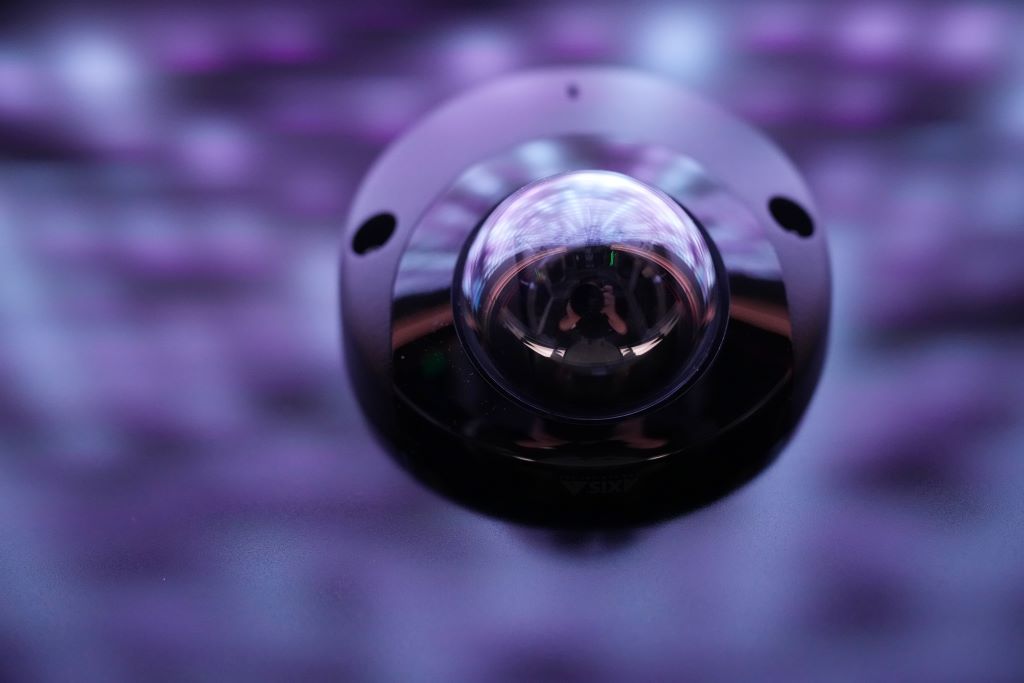
UTM: How does the current geopolitical and economic situation affect your company and your products in terms of inflation, price developments and market volume?
Maximilian Galland: Despite the current difficult economic situation, we have shipped more products in the EMEA region since March 2022 than ever before. The situation remains challenging due to limited availability of electronic components combined with high demand for Axis products. However, our operations team is working daily to secure the components we need, thereby reducing lead times to normal levels. Furthermore, we have taken a number of additional measures to ensure long-term supply: Among other things, we rely on multiple procurement, stable partnerships, redesign of certain products and increased production capacities.
UTM: In the industry, there is often talk of a shortage of specialized personnel. How do you respond to this and how attractive is Axis Communications for career starters and experienced specialists?
Maximilian Galland: As a technology leader in network video, Axis Communications is deeply rooted in the security industry. This also helps us to attract new employees. In recent years, we have increased our global headcount from 3,000 to 4,000. Professionals in the security industry are very well connected. Everyone knows everyone. When looking for new staff for our company, we therefore rely in particular on recommendations from our colleagues. They carry our good working conditions and our innovative and sustainable corporate culture to the outside world and act as ambassadors for the fact that Axis is an attractive employer.
13.03.2023
